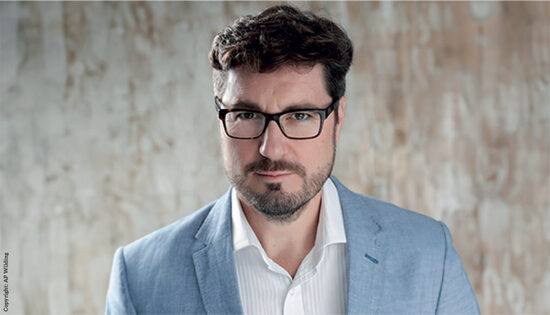Nick Gartside has seen a huge transformation in bond markets during his career, with some dramatic changes to the types of bond portfolios he has been running since 1997.
The JP Morgan Asset Management’s international chief investment officer for global fixed income and currency says this has made for a very interesting time. One of the key drivers in this huge evolution was the creation of the euro.
“What [the euro] facilitated was a shift from a lot of eurozone corporates having a financing relationship with their bank to more broadly accessing capital markets. That was a very good change if you work in fixed income markets, and it made them a lot more interesting in terms of the different countries, and then also in terms of the different assets that investors could buy.”
This translated beyond government bonds to investment-grade bonds and high-yield bonds and, later, European emerging market bonds.
Gartside started his career with Mercury Asset Management in 1997 but only began running a global strategic bond fund in 2007 when he was at Schroders, before moving across in 2010 to JP Morgan where he now co-manages the JPM Global Strategic Bond Fund Sicav with Bob Michele.
Radical changes to the portfolio since those early days reflect an increasing awareness that there is a big issue with the fixed income benchmark in that they reward bad behaviour, he says.
“In a world post-2007, where the world is awash with debt, there is quite a big contradiction with the fixed income index because, of course, fixed income indices are collections of debt.
“If a company or a country misbehaves it issues more debt, so its importance in the index goes up. You are allocating more money to an entity of a declining credit quality.”
On the same page
Investors now want to shift away from that sort of bad behaviour into a benchmark-unaware space, Gartside says.
“A strategic bond fund with a global remit can do that. The way we do it is to allocate to parts of the bond market that we feel are going up, irrespective of sector and geography.”
That vast global opportunity has led to an integrated investment selection process that Gartside describes as “very simple and powerful”.
“We ensure all of our investors speak the same language. Every investment team, every theme, every bond goes through three filters: fundamental, quantitative and technical. That means that you can talk to your Japanese bond group, who will come to a conclusion but you can understand how they have got there.
“We feel that we have actually a process that is consistent and repeatable, because each week we are looking at markets through those same three filters, and we feel that is powerful in unearthing ideas.”
But there are just three constraints on investment, which Gartside says is much less than most bond funds.
The first one is a maximum of 50% in high-yield bonds. The second is to mainly hedge the currency back to the base currency, which means a maximum of 20% in non-base-currency positions. The third constraint is duration, which will vary between zero and nine years.
“That is a pretty broad band, but it gives us a lot of flexibility in terms of constructing the portfolio, geography and sector.”
In it for the duration
Duration is effectively a measure of the sensitivity of the bond to movement in interest rates, with government bonds at one end of the spectrum and high-yield bonds in the increasingly less sensitive corner.
Gartside looks, in a very simplistic way, at what the headline duration is, and then works out “what we call our effective duration”.
An example of this latter point could be a portfolio duration of a year and a half, but actually that is all coming from high-yield bonds or local emerging-market bonds so the sensitivity to movements in interest rates, treasuries, gilts or bonds, is very low if not negative.
Adding up all the durations produces an average of 3.7 years, but this has been reduced to a headline duration of 1.8 years by selling government bonds.
“The real duration or sensitivity to interest rates is about zero because of allocation to some investment-grade credit bonds, some securitised bonds and some high-yield bonds,” he says.
The yield now is 3.5% on the fund. “That is better than cash, let’s put it that way, which is not saying much in this day and age.”
Cost of capital
Buying bonds that are not expected to default shore up the income flow, but what about capital growth?
“Increasingly a lot of fixed-income investors are going to have to try and generate capital gain and there are a couple of ways that we can do that.
“One way is through the yields declining on the bonds we own. So if we think of a high-yield bond today, it yields 6.65% – our sense is that by the end of the year that yield will be lower, so the return is then made up from the income and a little bit of a capital gain.”
The other way is to do relative-value trades, such as going long on some Australian government bonds and shorting US treasuries against it.
“Clearly we are expecting Australian government bonds to outperform US treasuries there. So you can do both, let’s say, a directional trade, we think high-yield yields will go lower, and then also a relative-value trade.”
There are between six and 12 strategies going on in the fund at any one time, and around 30% of the portfolio is invested in investment-grade bonds.
The selection of those securities is a “bottom-up” process done by JP Morgan’s in-house credit analysts which combined with a “top down” view to give what Gartside argues is the best of both worlds.
There is 35% in high-yield bonds issued by corporate high-yield companies, of which about 30% is in US and 5% in Europe. A further 20% is in securitised bonds, spread between the US, Europe and the UK, with the balance of 15% in cash.
There is no exposure to emerging-market debt currently, though there was some in the portfolio earlier in the year, nor are there any foreign exchange positions despite being quite active in this space at times.
Rates and recession
Looking ahead at the big picture, Gartside poses the question of whether markets are at the start of an aggressive rate-hiking cycle.
“We would suggest not. I mean, the commentary from policymakers suggests they want to keep interest rates for a long period of time. If you look at the pace of economic growth, it is still pretty low. If you look, and I think this is the key indicator, there is probably a greater risk of deflation as opposed to inflation. The minimal wage inflation evidence supports this argument,” he says.
The polar risk is whether markets are going into recession, in other words will the operating environment for corporates become so challenging they make less money, reducing the ability to service the debts.
“We don’t think that,” says Gartside. “A lot of corporates have got balance sheets in good shape, lots of cash flow and they have used this period of low interest rates to swap old, expensive debt for debt with a longer maturity at a lower interest rate.
“So our view has been to use this dislocation in markets as an opportunity to add some of the riskier fixed income assets, where we think the valuation part is now more interesting.
As for the default rate, globally it is around 2% and Gartside expects the figure to stay low.
“There are no big alarm bells saying that corporate leverage is very high and there is too much debt on balance sheets. You can look at lots of indicators and ratios and it is simply not suggestive of that.”
Against the backdrop of dislocations in fixed income markets, Gartside predicts the latter half of the year will see investors selling equities to buy bonds.
“This is not what people expect, but, ultimately, you have got a couple of sorts of investors – retail investors and institutional investors.
Institutional investors are doing precisely that trade, they are selling equities to buy bonds, because they want to minimise the gap between their assets and liabilities, and they do that by buying bonds.
“There’s a bit of a disconnect on timing. Retail investors act very quickly and institutional investors act in a bit more of a slow way,
but the aggregate of that is our sense that the high-yielding fixed-income assets are going to be the ones that appeal as we approach the end of the year.”








